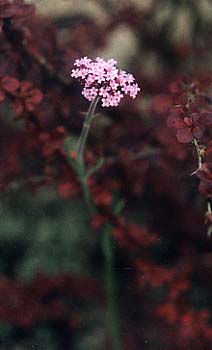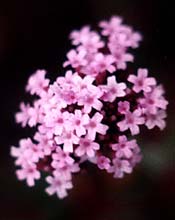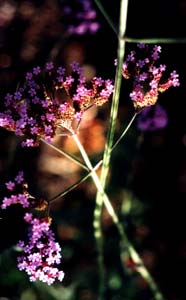
Brazilian Verbena
aka Tall Verbena
aka Purpletop Verbena
He plucked a beautiful flower;
Tore it away from its place
On the side of the blooming bower;
And held it against his face.
Drank in its beauty & bloom,
In the midst of his idle talk;
Then cast it down to the gloom
And dust of the garden walk.
-Ella Wheeler Wilcox
(1850-1919)
(1850-1919)
Brazilian Verbena was the first of the many South American verbenas to make it over to England. They were grown 1726 in the Eltham gardens of James & William Sherard, who obtained the first seeds from a dried specimen sent from Buenos Aires. We know this thanks to J. J. Dillen, first professor of botany at Oxford, who in 1732 documented William Sherard's gardens in the classic Hortus Elthamensis.
This is a tall gangly-looking but surprisingly sturdy plant with clusters of tiny violet or lavender-purple flowers at the tips of its many stems. It can bloom as early as March & in warmer areas it will still be blooming in November. On Puget Sound it blooms until first frost. It is at its height of bloom in summer, as it greatly enjoys the heat, being native of warmer areas of Argentina & Brazil, but for us there are still many of its bright flowers in chilly October.
 The pictures on this page are of first-year plants we got as starts from a friend's garden. They were the beginning of what became quite a densely planted mixed-border of low-maintence perennials along the roadside. The plant in the background is a Japanese Red Barberry. Even as a single, thin, four foot gawky beginning of an eventual perennial clump, the verbena bloomed right away, & quite prettily, as shown in July snapshots first & second. The third photo is from late September.
The pictures on this page are of first-year plants we got as starts from a friend's garden. They were the beginning of what became quite a densely planted mixed-border of low-maintence perennials along the roadside. The plant in the background is a Japanese Red Barberry. Even as a single, thin, four foot gawky beginning of an eventual perennial clump, the verbena bloomed right away, & quite prettily, as shown in July snapshots first & second. The third photo is from late September.The somewhat "lacecap" shaped blooms are of the type called cyme. The centermost buds within the cyme open first, & the buds at the edge of the cluster open last.
 Planted very near it but never raising its stems & flowers more than a foot from its prostrate clump is Verbena canadensis 'Homestead Purple', with the same kind of blossoms except deep rose-pink with the individual blossoms in the cyme lacecap much larger. Behind the Barberry is a related creeping sub-shrub closely resembling the Homestead Purple, but the cymes are the brightest orange-gold on the Lantana camara 'Radiation.' Beside the verbena clumps is Centranthus ruber 'Coccineus' Red Valerian which has a similar appearance to the Brazillian Verbena but with the brightest red lacecaps. These all have in common low-maintenance minimal watering needs.
Planted very near it but never raising its stems & flowers more than a foot from its prostrate clump is Verbena canadensis 'Homestead Purple', with the same kind of blossoms except deep rose-pink with the individual blossoms in the cyme lacecap much larger. Behind the Barberry is a related creeping sub-shrub closely resembling the Homestead Purple, but the cymes are the brightest orange-gold on the Lantana camara 'Radiation.' Beside the verbena clumps is Centranthus ruber 'Coccineus' Red Valerian which has a similar appearance to the Brazillian Verbena but with the brightest red lacecaps. These all have in common low-maintenance minimal watering needs.The water requirement for Brazilian Verbena is very low. It has few or no demands if positioned in sun in extremely well-draining soil. It will need moist soil when getting started, but once established, normal rainfall will likely be sufficient. It will do well in poor soil, but will be at its best in soil enriched with a considerable amount of organic matter. A slow-release fertilizer at the beginning of each spring is plenty.
Brazilian Verbena grows four to six feet tall or even seven feet as an upright clump of slender, thinly leafed crisscrossing stems. It self-seeds & can be hard to restrain. It has fully naturalized in areas of California, the southwest, & southeast. In the Northwest it is not so inclined to escape gardens because it stops where it encounters a lot of dampness. But it certainly will seed itself nearby, & newly seeded plants will bloom within one year. In zones colder than its preferred range, it can still sometimes be grown successfully as a self-seeding defacto annual.
Butterflies & bees love it. Its cut flowers are long-lasting in bouquets. The leaves look delicate but the leaves & stems are actually fairly stiff. Unlike some tall thin plants, it is not inclined to tip over.